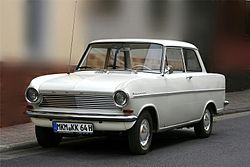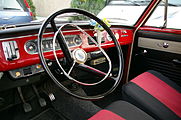Opel Kadett A.
| Opel | |
|---|---|
|
Opel Kadett (1962-1965)
|
|
| Cadet A. | |
| Production period: | 1962-1965 |
| Class : | Lower middle class |
| Body versions : | Sedan , station wagon , coupé |
| Engines: |
Otto engines : 1.0 liter (29–35 kW) |
| Length: | 3920 mm |
| Width: | 1470 mm |
| Height: | 1410 mm |
| Wheelbase : | 2325 mm |
| Empty weight : | 670 kg |
| successor | Opel Kadett B. |
The Kadett A from Opel was the second model in the Kadett / Astra car series that has been produced to this day . The model, which at the time belonged to the lower middle class, was completely redesigned including the engine. The type was manufactured from 1962 in the newly built Opel plant in Bochum . In September 1965, it sparked the Kadett B from.
Model history
General
With this model, Opel revived the old name Kadett . Even before the Second World War, an Opel Kadett was produced in Rüsselsheim from autumn 1936 to mid-1940 .
In 1957, Karl Stief (Opel chief designer from 1934 to 1959) received the order from the US headquarters of the Opel parent company General Motors to design a "perfect anti-VW", meaning the VW Beetle . With his assistants Hans Mersheimer (body) and Werner K. Strobel (engine and chassis), Stief pushed the development work forward so secretly that hardly anything was known about the development history of the Kadett A. It was not until construction began on the new Opel plant in Bochum in 1960 that the public learned that Opel was working on a new small car that was launched on the market in June 1962 for DM 5075 (L version: DM 5525). Adjusted for inflation in today's currency, this corresponds to 11,200 and 12,200 euros.
The sporty coupé, which was produced from September 1962, at a price of DM 5775, helped liberate Opel from the staid "suspender image" of the 1950s. 53,468 coupés left the Bochum plant.
The Caravan 1000 built from March 1963 for 5445 DM is the rarest model of the Kadett A series in Germany today. Many were exported, the rest were worn out as "workhorses" in everyday life. With the luxuriously equipped Kadett A Caravan 1000 "Privat", the station wagon lost its reputation as a dingy craftsman's car and became a practical family limousine with a large load space.
technology
body
With the Kadett, Opel wanted to compete with the VW group, which dominated the market with the conceptually outdated VW Beetle. In addition, the Kadett offered the occupants significantly more space in its modern self-supporting body with better visibility and a larger trunk. It was also shorter and lighter.
No four or five-door models were built by the Kadett A. This was only available on request with the successor Kadett B.
However, the design received a mixed response, it was assessed as conservative to unbalanced. Part of this impression were the unusually small 12 '' wheels, which, however, allowed a spacious rear area without protruding wheel arches. Later it became extremely susceptible to rust, so that the Kadett A, despite large numbers, had largely disappeared from the German streetscape by the mid-1970s - in contrast to VW Beetles of the same age.
engine
The 96 kg 1.0 liter engine in the Kadett A was the first engine that was completely redesigned at Opel after the war. The longitudinally mounted short stroke with overhead valves and a power of 40 HP (29 kW) at 5000 min -1 was fundamentally different from the other four cylinders of the company, still on the in 1937 Opel Olympia based motor used. It offered better performance and lower fuel consumption than the VW Beetle. Furthermore, the Kadett had more efficient heating due to the water cooling .
Instead of spur gears , a single roller chain with a hydraulic tensioner drove the high-lying camshaft . The light valve train made of sheet metal rocker arms and hollow bumpers allowed high speeds - over 6000 min −1 were possible. The forged crankshaft had three bearings . The pistons made of an aluminum alloy were provided with bimetal stretch strips (autothermal) to control thermal expansion. The single-forked intake manifold was made of light metal and sat on top of the cylinder head. The 40 hp engine could run on regular gasoline (90 octane ).
The coupé had the 1.0 “S” engine, increased to an output of 48 hp (35 kW) as standard, which was also available as the Kadett “Super” for the other body variants from September 1963. The twenty percent higher output was achieved with a modified intake manifold, a different piston and camshaft design and a higher compression ratio . This is why the “S” engines also needed 98 octane super fuel.
Unlike the body, the Kadett's new engine was considered very reliable. It was used by Opel with a displacement of up to 1.2 liters and several performance increases in various models until the early 1990s.
Power transmission and chassis
The manual transmission was "fully synchronized ", that is, including first gear. The synchronizer rings with pawls caused the “locking synchronization”: the gear could only be engaged when the gearwheel and the shift sleeve had the same speed. The four-speed gearbox “fully and lock-synchronized” in this way was operated via a long center shift lever (“stick shift”). That was unusual for Opel, as the larger “ Rekord ” and “ Kapitän ” models of that time all had three-speed transmissions and steering wheel shifts as standard .
Last but not least, in order to achieve efficient and cost-effective production, the Kadett once again made use of the conventional concept of the front engine with rear-wheel drive via a rigid axle . The rear axle, known as the central articulated axle, was, however, newly developed: the differential housing of the rear axle had a forward-facing boom that transferred the braking and drive torques to the two-leaf springs. The cardan shaft could be connected directly to the central joint without any further joints. This also reduced the space required by the cardan tunnel in the passenger cell. The front wheels were also leaf-sprung and individually suspended on double wishbones of different lengths . Opel called the transverse spring a "wide-gap half-spring". It was stored at two points and thus also served as a stabilizer . The brake system with hydraulically operated drum brakes at the front and rear generated sufficient braking deceleration with low pedal forces even without a brake booster . The Renault 8 had at that time, however, already all around disc brakes.
Body and equipment variants
Production numbers
The Kadett A rolled off the production line in a total of 649,512 units during its relatively short production period from June 1962 to August 1965. This includes the CKD kits , which were assembled from 1963 in the GM plants in South Africa, Denmark, Belgium, Portugal, Uruguay, Peru and Venezuela.
USA export
From February 1964 to autumn 1965 the Kadett A was also exported to the USA, where it was sold through around 500 Buick dealers. The program included the two-door sedan and caravan (1.0 liter, 46 SAE gross hp / 34 kW) and the Coupé called Sports Coupe (1.0 liter, 54 SAE gross hp / 40 kW).
Technical specifications
| Opel Kadett: | 1000 | 1000 p | |||||
|---|---|---|---|---|---|---|---|
| engine | Four-cylinder - inline engine ( four-stroke - gasoline engine ) | ||||||
| Displacement | 993 cc | ||||||
| Bore × stroke | 72 × 61 mm | ||||||
| Power at 1 / min | 29 kW (40 hp) at 5000 | 35 kW (48 hp) at 5400 | |||||
| Max. Torque at 1 / min | 70.6 Nm (7.2 mkp) at 2200 | 70.6 Nm (7.2 mkp) at 2800 | |||||
| compression | 7.8: 1 | 8.8: 1 | |||||
| Mixture preparation | an Opel downdraft carburetor (Carter license) with an acceleration pump and intake air preheating |
||||||
| Valve control |
OHV (hanging valves), sheet metal rocker arm , side camshaft with drive via single roller chain |
||||||
| cooling | Water cooling | ||||||
| transmission | fully synchronized four-speed manual transmission , center shift lever ("stick shift") | ||||||
| steering | Rack and pinion steering | ||||||
| Front suspension |
Independent suspension on double wishbones of unequal length , three-layer leaf spring (wide-gap semi-spring), telescopic shock absorber |
||||||
| Rear suspension | rigid ( central articulated axle) on the axle drawbar and semi-elliptical leaf springs (sedan and coupé two-ply, caravan three-ply), telescopic shock absorber | ||||||
| body | Sheet steel, self-supporting, tank capacity 33 liters | ||||||
| Front / rear track | 1200/1205 mm | ||||||
| wheelbase | 2325 mm | ||||||
| length | 3923 mm (L and Coupè: 3990 mm) | ||||||
| Empty weight | 670-720 kg | ||||||
| Top speed | 120 km / h | 135 km / h | |||||
| 0-100 km / h | 28 p | 19 s | |||||
| Consumption in liters / 100 km (sedan) | 7.5-10 (regular gasoline 90 octane ) | 7.5-9.5 (super gasoline 98 octane) | |||||
Individual evidence
- ↑ The amounts were determined with the template: Inflation , have been rounded to a full 100 euros and refer to the previous January.
- ↑ On the technology of the utility vehicle with a displacement of 1 liter . In: Motor vehicle technology 1/1963, pp. 14-16
- ↑ auto motor und sport issue 19/1962
- ↑ On the technology of the utility vehicle with a displacement of 1 liter . In: Motor vehicle technology 1/1963, pp. 14-16.
literature
- Stefan Dierkes: Opel Kadett A - Bochum, I come from you. Delius Klasing, Bielefeld 2007. ISBN 978-3-7688-1918-3 .
- Werner Oswald: German Cars 1945–1990 , Volume 3. Motorbuch Verlag, Stuttgart 2003. ISBN 3-613-02116-1 .
- Mike Covello: Standard Catalog of Imported Cars 1946-2002. Krause Publishing, Iola 2006. ISBN 0-87341-605-8 .
- Dieter Korp: Now I'm helping myself , Volume 5.Motorbuch Verlag, Stuttgart, 6th edition 1971.









